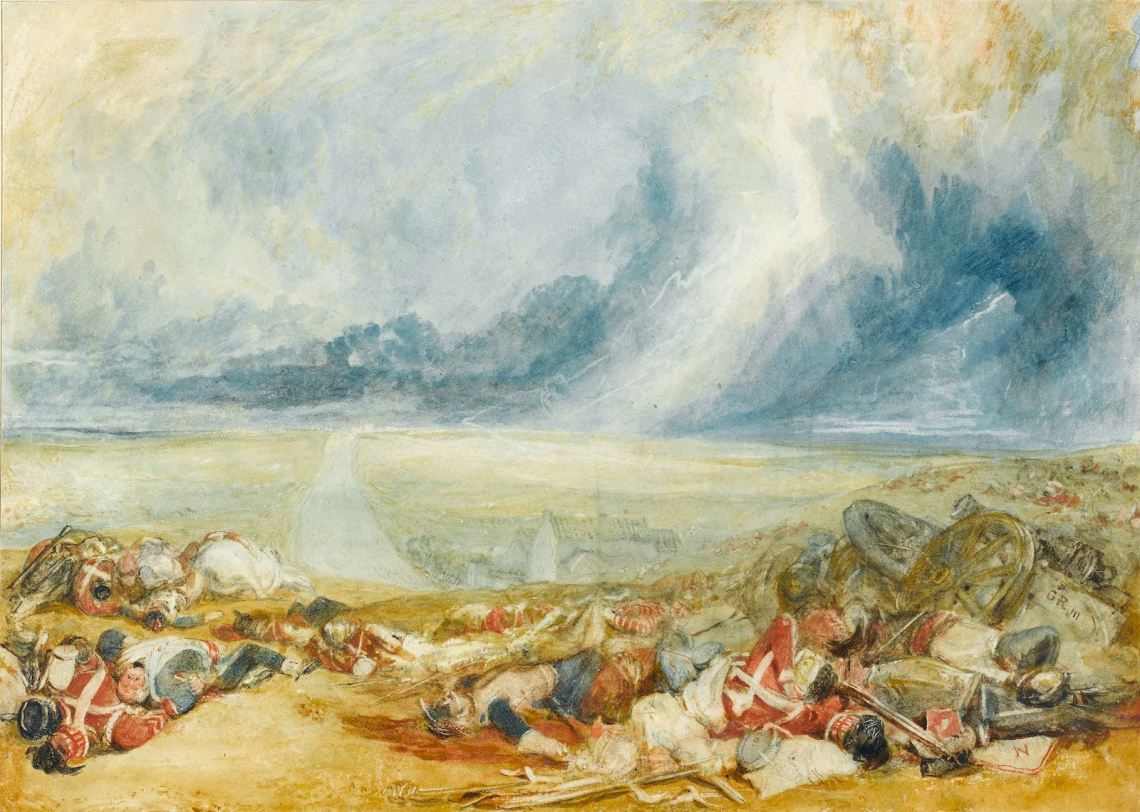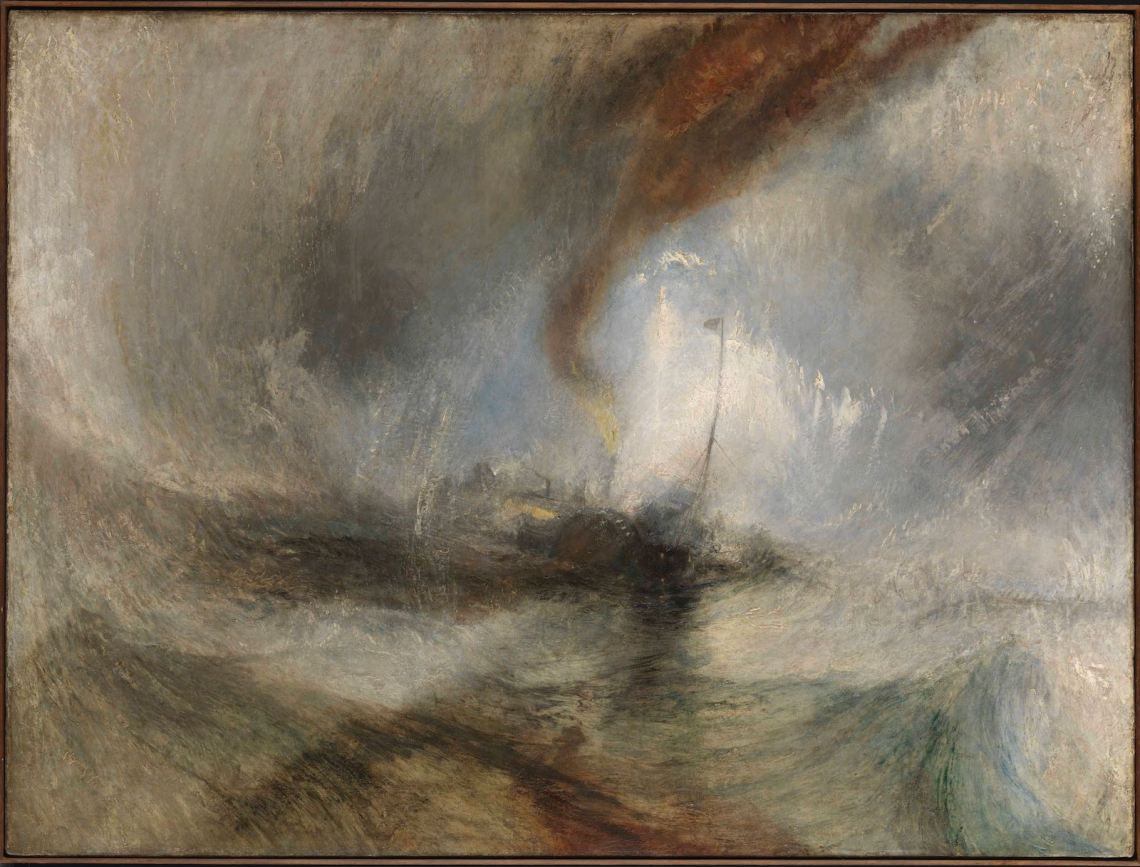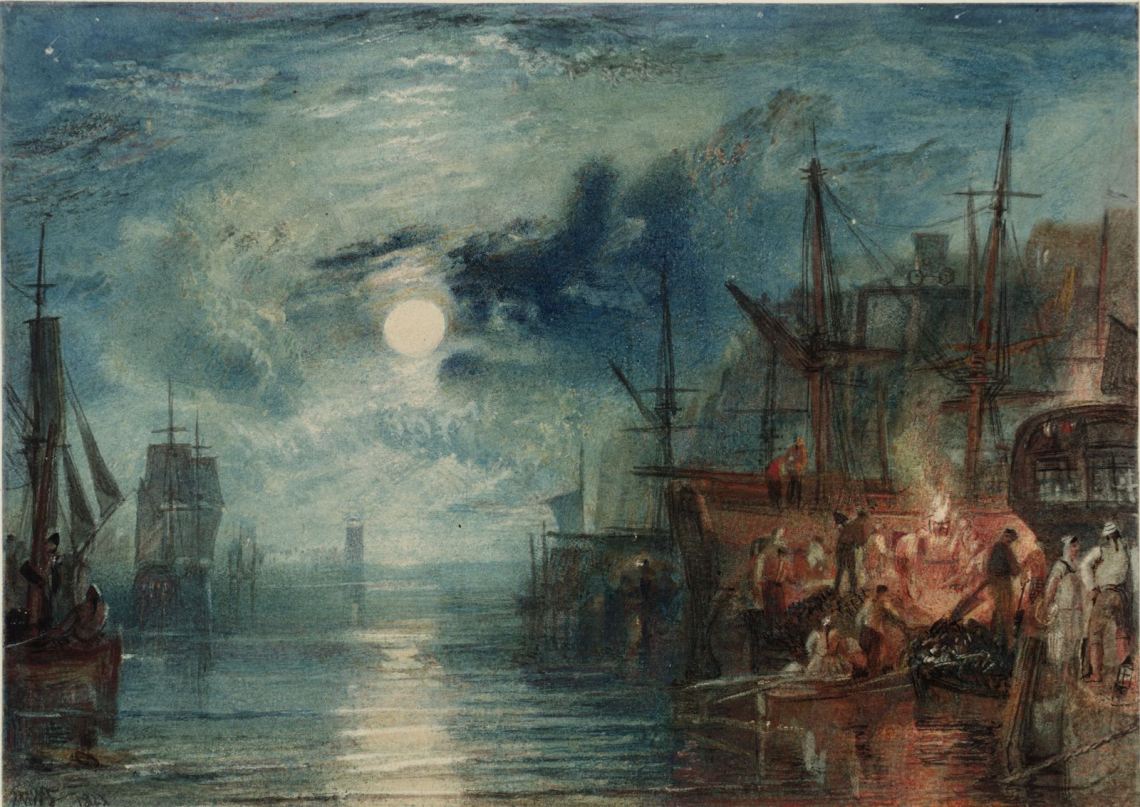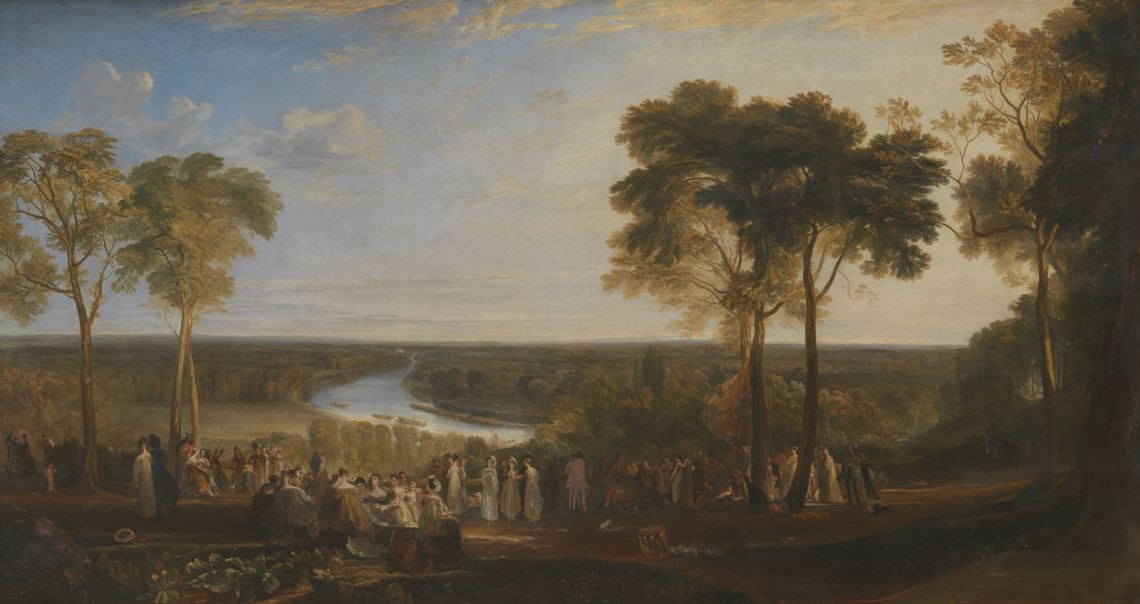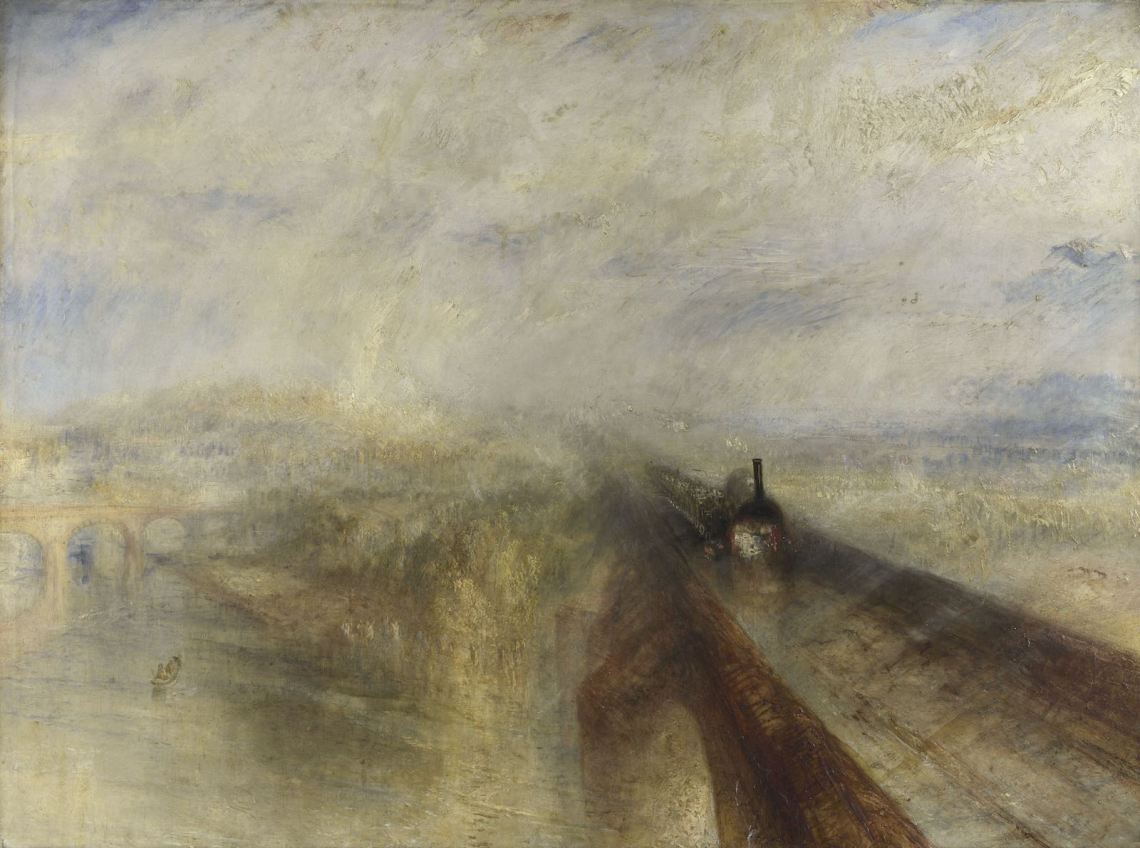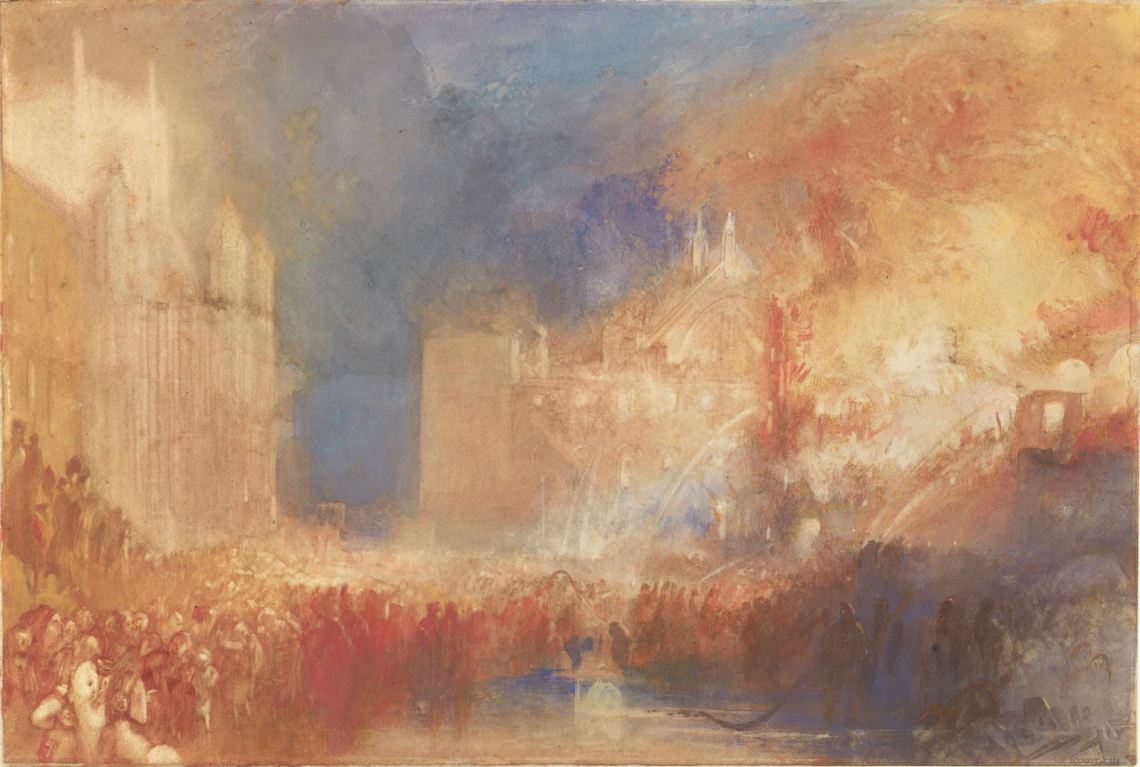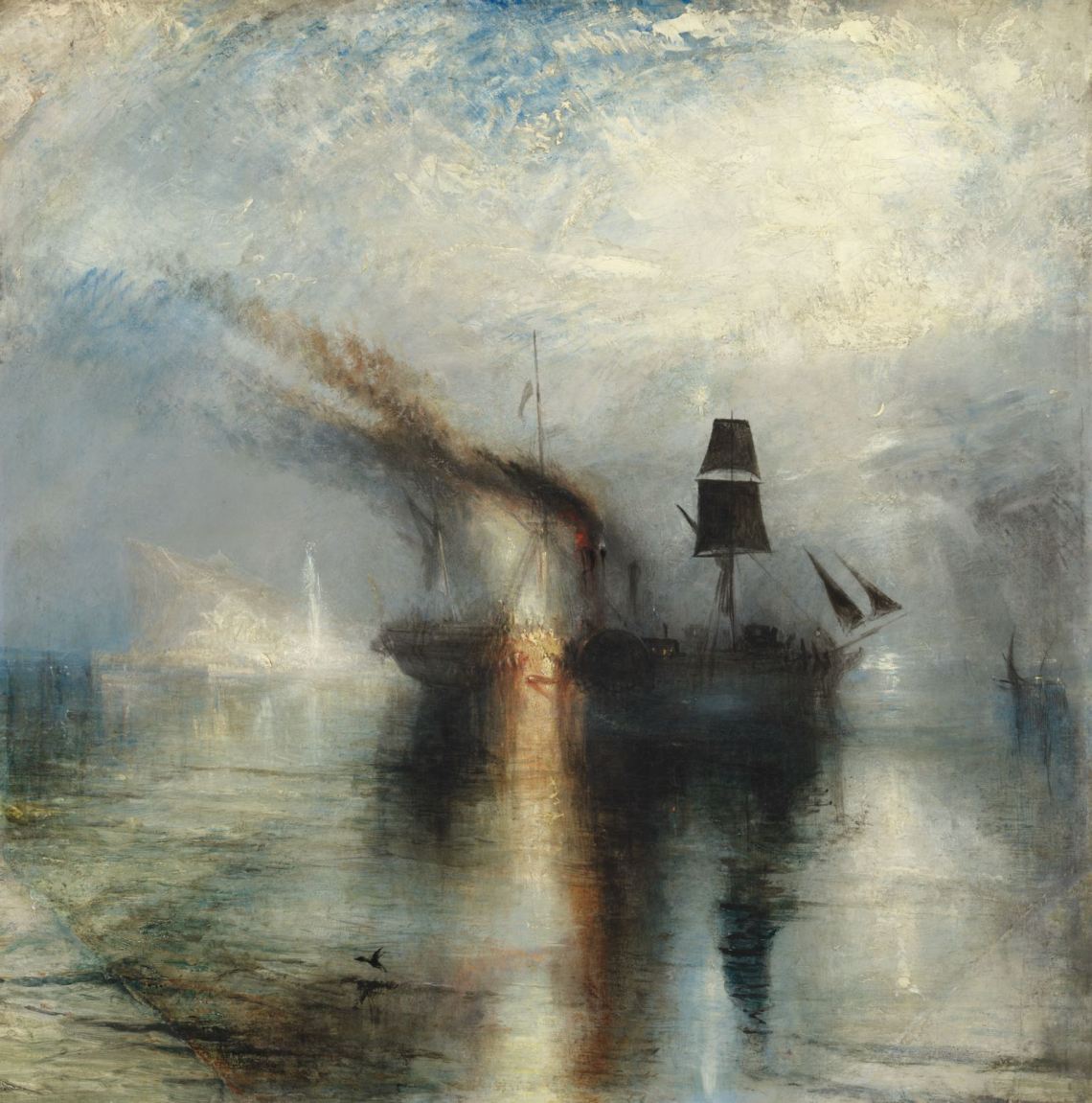Who knew that the postmodern Armageddon would feel quite so peaceful? On a bright autumn morning, as the pandemic’s second wave rolls in, the streets of Westminster are quieter than on a Sunday dawn. Here, the British state and its offshoots—the public bodies, the think tanks, the charities—normally throng and hum. But the state and its appendages are working from home, so you enter Tate Britain from a near-deserted riverside where a solitary leaf-collector blows autumn into piles. Once inside, in the Tate’s new exhibition of works by J.M.W. Turner, crisis and catastrophe explode in ecstatic vortices of light and shadow, blaze and mist. Two centuries ago, emergencies really acted up.
The paintings, drawings, and sketches in “Turner’s Modern World,” enact convulsive scenes of warfare, industry, empire, and revolution. Some kind of spectacular apocalypse—natural, human-induced, or a mix of both—is never far away. It flares in lurid sunsets above corpse-strewn battlefields. It hangs in toxic fogs over factories and forges. It rips through cloudbursts and seascapes where many-masted ships burn, splinter, and sink.
The French writer Théophile Gautier saw the incandescent monster of a speeding locomotive depicted, for almost the first time in Western art, in Turner’s Rain, Steam, and Speed—The Great Western Railway of 1844 as “the Beast of the Apocalypse.” When Turner draws the Houses of Parliament as they burned down in 1834, an event that was, to many contemporaries, a fitting fate for oligarchy and corruption, a seething crowd watches the Biblical light show. You imagine the cheers. Even a deadly pandemic may take a mythic shape. A ghastly skeleton collapses on its steed amid a hellish fog in a canvas of 1833 captioned The Fall of Anarchy. The curators of “Turner’s Modern World” now believe that this work illustrates Shelley’s satirical, revolutionary poem “The Masque of Anarchy,” but its previous title, Death on a Pale Horse, hints at a connection to the devastating plague of 1832, when, in its rampage across the globe, “King Cholera” killed more than 50,000 in Britain alone and terrified the artist himself.
At the time, doctors believed that tainted air, rather than contaminated water, caused the disease. But then, no one who pays attention to Turner’s weather could ever think of atmosphere as innocent. Technicolor-tinged by belching smoke from factory chimneys or foundry fires, his skies and clouds glower over workers lured from the countryside to operate the plants that powered the Industrial Revolution. The curators point out that the full-spectrum sunsets and cloudscapes that envelop Turner’s industrial towns and workshops reflect not just Romantic aesthetics; they also register the meteorological effects of greenhouse-gas pollution. In The Thames Above Waterloo Bridge (circa 1835), painted decades before Claude Monet immortalized Victorian London’s smoky haze, Turner renders the capital’s air as a miasma of sulfurous orange, brown, and gray. These are crime scenes of the early Anthropocene.
Forget Turner the dreamy purveyor of deliquescent landscapes, or the patriotic peddler of radiant English idylls. He could do all that, of course, for payment or prestige. But his vast, gorgeous panorama entitled England: Richmond Hill on the Prince Regent’s Birthday (1819) went unsold. The curmudgeonly polymath seldom got on well with grandee patrons (apart from one radical landowner, a Yorkshireman named Walter Fawkes). Instead, he hung out with the intellectuals who researched the natural phenomena captured and transformed in his art: pioneers such as the chemist Humphry Davy, whom Turner met in Rome, or the Scottish mathematician and astronomer Mary Somerville, the first person ever called a “scientist.” It was Somerville who wrote that “Steam…annihilates time and space”: a motto for the industrial modernity that, as the Tate selection proves, absorbed Turner more than any of his peers. He painted from inside the belly of the beast.
The exhibition brings the military-industrial complex of the early nineteenth century to livid, often scary, sometimes poignant life. In the overfamiliar The Fighting Temeraire Tugged to her Last Berth to be Broken Up (1839), which now adorns the British twenty-pound note, a perky tugboat with a phallic smokestack pulls the elegant, ghostly, feminine man-of-war. Sail submits meekly to steam. Scarlet, black, or purple skies above scenes of battle reflect the blood and torn flesh of the mangled victims groaning beneath in The Field of Waterloo (1818). Researched on-site, it foregrounds the women who succor the wounded as they lie in a tangle of suffering that knows no flag or nation. Turner, often inspired by the poetry of his time, quoted Byron’s description of “friend, foe,—in one red burial blent!” after the carnage. Angry starbursts of artillery light up the dark skies behind.
Advertisement
The Tate curators compare this work to the antiwar masterpieces of Francisco Goya and Pablo Picasso. For sure, here and elsewhere, Turner shuns chauvinism. He was drawn to tragedy, not victory. Even his self-consciously “epic” picture of The Battle of Trafalgar, 21 October 1805 (1822), with its newsreel-style chronicle of Nelson’s fatal triumph, pulls the eye away from the heroic deeds on deck to the curiously abstract dance of shapes performed by interleaving French and British sails. As a commentator on current events, he’s often circumspect, even cryptic, but his radicalism deepened in response to state repression during the Napoleonic wars—in 1805, the future artist of The Slave Ship (1840) made a small (and bad) investment in a slave-worked Jamaican cattle ranch.
His forty or so works prompted by the career of Napoleon Bonaparte span a range of attitudes, from spotlit celebration to bitter irony and almost comic bathos. In the late painting War. The Exile and the Rock Limpet (1842), the banished emperor has less freedom than a sea snail on the sands of St. Helena. Views of pastoral and monumental England—a staple of Turner’s career, which was sustained by sketching tours—offset bucolic bliss with renderings of hard labor and endemic poverty. Does the presence of farm workers in Ploughing Up Turnips, near Slough (1809) in the shadow of Windsor Castle pay homage to the scientific planting program promoted by King George III (an enthusiasm that earned him the sobriquet “Farmer George”), or caustically contrast royal pomp with the backbreaking toil of a dispossessed rural proletariat?
As a high-profile public artist, famous but controversial, Turner had to keep potential enemies, as well as friends, close. In a watercolor scene of an (uncontested) election in Northampton, the figure of Marianne—emblem of revolutionary France—taps a gouty old gent on the shoulder. A warning of tumult to come? Yet the local magnate obediently returned to Parliament by this electoral formality was no reactionary diehard but the enlightened Viscount Althorp, a friend of Turner’s and a staunch progressive who spearheaded the fight to pass the Great Reform Act of 1832. In politics, as in paint, Turner blurs perspectives, softens angles.
His technique itself breeds ambivalence. His art refracts judgment just as it refracts light. He brought sublimity, which Edmund Burke had defined as a “sort of delightful horror,” to military and social conflict as well as cataracts and crevasses. John Ruskin, whose limiting advocacy of Turner’s work sought to brand him as a painter of nature rather than society, thought that he had fashioned the rushing engine of Rain, Steam, and Speed “to show what he could do with an ugly subject.”
Beyond doubt, he made ugly subjects beautiful. The transported female convicts who drown in A Disaster at Sea (1835) may express his righteous dismay at the savage penal laws that exposed the poor to such dangers. But they also let Turner answer Théodore Géricault’s iconic The Raft of the Medusa (1818–1819), which he had probably seen in London, in his own barnstorming style. Here, the deaths of 108 women and twelve children become the occasion for a bravura show of virtuosity. Bodies in peril punctuate a rapturous delirium of wave and storm.
Turner can certainly make misery appallingly pretty. This capacity to aestheticize the abject comes to a head in the much-debated Slave Ship, subtitled Slavers Throwing Overboard the Dead and Dying—Typhoon coming on. Turner painted it in 1840, seven years after the parliamentary abolition of slavery in most of the British empire, just as the World Anti-Slavery Convention gathered in London. It’s thought to portray the notorious massacre that took place on the Zong in 1781 so that its owners could claim insurance on their lost “cargo.” But the illegal traffic in slaves had not ended with the 1833 emancipation, and Turner’s “historical” canvases often illuminate current events. Again, drowning bodies—African ones here, splintered into clutching, flailing limbs—waymark a storm-wracked seascape, washed with blood under heaving, glowing skies.
Black British writers have taken cues from the aura of heartless aestheticism that hangs over this work—notably, David Dabydeen in his narrative poem Turner and Winsome Pinnock in her play Rockets and Blue Lights. For Pinnock, Slave Ship invites not a passive delight in atrocity, but a deeper engagement that “asks you to think, and to take action.” For the critic and historian Simon Schama, Turner’s optical extravaganza does not distract from the call to conscience. To him, the painting delivers “the greatest union of moral power and poetic vision that British art ever accomplished.” Schama notes, in his book and TV series Power of Art, that the spectator needs to visit and see Slave Ship in the original in order to feel it “explode off the wall as you stare at the churning chasm in the pitchy ocean.” At the Tate, however, you can only view a reproduction: it was deemed too fragile to travel from its permanent home in Boston’s Museum of Fine Arts.
Advertisement
This matters. Reproduction flattens Turner’s eye and mind. Up close, the heavily worked and fiercely personal oil paintings of “Turner’s Modern World” disclose the human plight beneath his pyrotechnic spectacles. Natural forces, often chemically enhanced by gunpowder or fossil fuels, may dwarf the puny creatures who work, fight, swim, or drown under all this epic weather. Pay heed, though, and you perceive how stabs and points of light, or ripples of jagged paint, make human figures gleam out from the ambient murk or glare that threatens to overwhelm them. And not just human figures: the hunted, bleeding cetacean in the extraordinary Whalers (1845) breaches out of the turbid ocean in a dying protest against the industrialized slaughter that harvested whales for commodities ranging from machine oil to candles and corsets.
If people may be victims in Turner’s art, they are perpetrators, too. “All that is solid melts into air,” wrote Karl Marx and Friedrich Engels in The Communist Manifesto, three years before Turner’s death in 1851, about the boundary-blurring energies of industrial capitalism. Often, in his work, modernity itself becomes that poisoned air. Transformations unfold in smoke, gale, or eclipse. Epoch-making change rolls in on choking smogs. His art foreshadows a world in which climate not only echoes and mimics human moods and desires, but where humankind—so tiny, faint, and frail in many of these pieces—makes the weather itself. In the bracingly clear light of a depopulated London, next to a river cleaner than it has ever been since Turner’s time, the Tate presents the artist’s prescient witness to the ecological calamity that threatens us all.

